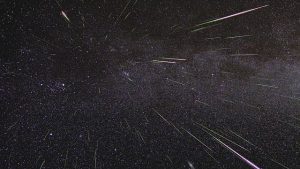Look up at night or just before dawn. You might see a meteorite zooming across the sky from now through mid August.

The Delta Aquarid meteor shower which peaks July 28 is best viewed in the Southern Hemisphere but you might see a flash of light looking south. This week is fairly good to sky watch because there is a waxing crescent (just a sliver of a moon).
In addition, the Northern Hemisphere’s popular Perseid meteor shower that peaks Aug. 12/13 in 2017, has already started so you might catch one of its meteorites almost anywhere in the sky.
Unfortunately for Perseid watchers, following a full moon Aug. 7, there will be a waning gibbous moon with about 77 percent illumination Aug. 12 and 67 percent illumination Aug. 13, so the moonlight will make it harder to pick up the meteorites. The Perseids can still be seen though there are fewer of them during the next waxing moon Aug. 16-18.
The Delta Aquarids and Perseids
The Aquarids are named for Skat, a star whose Greek name is Delta Aquarid. The star is below the Great Square of Pegasus in the Piscis Austrinus constellation. For more Aquarids info and a meteor shower calendar click on Earth Sky.
The Perseids go all over the sky but radiate from the Perseus constellation. They are coming from the Swift-Tuttle comet. You see them when Earth crosses its orbit. Visit NASA and Meteors for NASA’s Perseid information

One thought on “Meteor Watch”
Comments are closed.